In comparison to thermosetting polymers, the processing of thermoplastics composites leads to much faster manufacturing speeds. But the manufacturing process is not always problem-free. However, the findings of two PhD students in the ThermoPlastic Composite Research Center (TPRC) at the University of Twente (UT) suggest that this may now largely be a thing of the past. The TPRC is a research centre in the field of pre-competitive research into thermoplastic composites and has several partners, including Boeing, TenCate and Fokker Aerostructures.
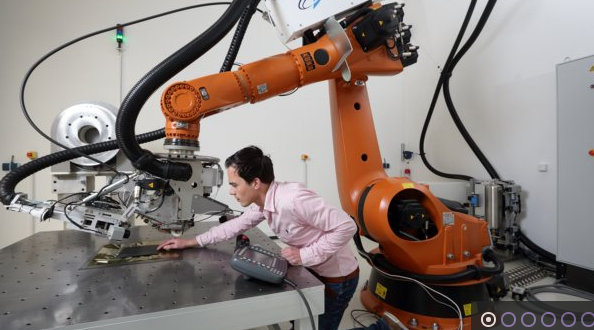
Ulrich Sachs and Sebastiaan Haanappel are on the verge of a breakthrough that will allow for the wide-scale use of thermoplastic composites in the automotive industry, for which weight reduction and reduced cost must be satisfied. These ‘futuristic materials’ are ultra-light, while being strong and rigid and also sustainable and recyclable. Sachs and Haanappel have recently overcome the last hurdle, which is to design practically faultless components and to make the process for doing so predictable. This makes it possible to determine at an early stage of the design process whether a component can be manufactured at all.
Need to search for automotive approved plastics?
Automotive Plastics Search in Prospector can help you quickly find plastics approved for automotive applications from more than 70 automotive OEMs.
Learn more
“All of the large car manufacturers have a need for thermoplastic composites,” says Bert Rietman, business developer at the TPRC. “Products made with these materials can be up to around 40% lighter than the materials usually used in cars and therefore bring great advantages. But many manufacturers are still not keen. The experience they have gained processing steel, for example, cannot be wholly transferred to composite processing.”
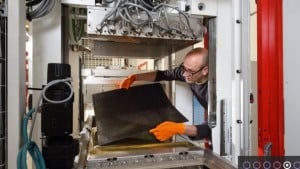 To come up with the right form and to avoid trial and error as much as possible during the design process, Sachs carried out research into thermoplastic composites. Only when designers completely understand the way the materials bend and slip will it be possible to make completely faultless products. “Designers want to know whether a component can be manufactured or not as quickly as possible,” explains Sachs. “For example, they want to know whether the material will wrinkle during forming, and whether the final product and the manufacturing process will be satisfactory. The automotive industry requires simulation of new materials and processes, but the software for forming metal currently in use is not suitable for simulating the behaviour of thermoplastic composites. This means that totally new software is needed in order to allow all of the pieces to fall into place. And we have now designed this software.”
To come up with the right form and to avoid trial and error as much as possible during the design process, Sachs carried out research into thermoplastic composites. Only when designers completely understand the way the materials bend and slip will it be possible to make completely faultless products. “Designers want to know whether a component can be manufactured or not as quickly as possible,” explains Sachs. “For example, they want to know whether the material will wrinkle during forming, and whether the final product and the manufacturing process will be satisfactory. The automotive industry requires simulation of new materials and processes, but the software for forming metal currently in use is not suitable for simulating the behaviour of thermoplastic composites. This means that totally new software is needed in order to allow all of the pieces to fall into place. And we have now designed this software.”
To be able to predict distortions during the press forming process for thermoplastic composites, the TPRC uses AniForm Suite software, developed by AniForm Engineering, a UT spin-off company. The simulation software makes it possible to evaluate whether a product can be manufactured at an early stage in the design process, and also helps to gain a better understanding of the way a particular composite material behaves.
An innovative final product was the result of one of the collaborations that came into being through the TRPC, when Johnson Controls developed a concept for a lightweight car seat. The seat was first presented at ITHEC (a large international exhibition on thermoplastic composites held in Bremen) in October 2014. This biennial event is held in the International Congress Centre of the Bremen Exhibition Centre, and is aimed at international industrial companies and research groups from a range of specialist fields, such as the automotive, aerospace and energy sectors.
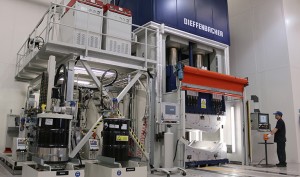
That is not to say that developments in thermosetting composites are standing still. At CAMX 2015 (Dallas, October), and Composites Europe 2015 (September, Stuttgart), Cytec exhibited new composite materials and technologies for high volume automotive production, including structural and tooling pre-pregs, resin infusion systems and structural adhesives that are complemented by a range of process materials available as roll stock or tailored kits.
For the automotive industry, Cytec is offering a new rapid cure resin systems for hot compression moulding of tailored pre-preg flat blanks with MTM 710 and MTM 23, as well as HP-RTM with XMTR50TM. For aerospace applications, Cytec’s out of autoclave (OOA) product collection includes vacuum bag only (VBO) pre-pregs such as CYCOM 5320-1 and MTM 45-1, and the primary structure ready PRISM EP2400 resin system.
Products on show at the European show include:
-
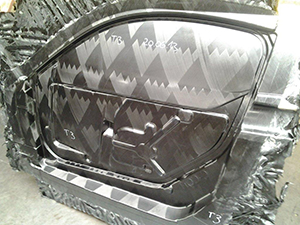
Cytec’s carbon fiber reinforced door structure. A carbon fibre reinforced door inner structure, manufactured from a filament wound flat blank using hot compression moulding technology. Filament winding is a flexible and efficient process for making flat pre-preg blanks of variable thickness. The material offers high conformability required for complex shapes, combined with mechanical properties comparable to conventional pre-pregs.
- A carbon-fibre reinforced tailgate manufactured from Cytec’s new rapid cure epoxy prepreg MTM 710 and with sub 3 minutes cure capability by hot compression moulding.
- A complex part manufactured from unidirectional carbon fibre, utilising an innovative automated preforming process which requires virtually no direct labour and is capable of producing parts such as structural automotive components for body-in-white structures with a sub 5 minutes takt time (Takt time is the average time between the start of production of one unit and the start of production of the next unit.)
- An HP-RTM demonstrator part made using Cytec’s XMTR750 two-component epoxy resin, with a sub 3 minutes cure capability, a mould temperature of 130C and with a resin injection time of less than 12s. XMTR750 enables serial manufacture of body structure components.“We are working closely together with our composite supply chain partners to develop materials, processes and application engineering that makes it possible to design and produce high performance structures in large series, with high levels of automation, and at competitive costs,” says Alex Aucken, Cytec’s Global Automotive Director.
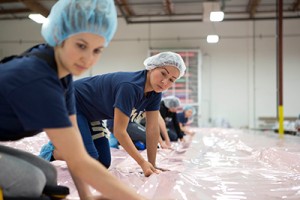
Cytec also showcased its innovative DForm Fabric Tooling pre-preg, which was launched earlier this year. Cytec believes DForm will transform composite tooling manufacture by reducing tool layup times by 75%, and making composite tooling more competitive than ever against metal tooling.
Finally Cytec promoted its added value kitting services, now offered out of its new Toulouse site, France. This facility has the capacity needed for the manufacture of large vacuum bagging consumable kits for applications such as aircraft wings or wind turbine blades. Kitting brings great benefits to part manufacturers such as reduced labour cost, total production time and waste, as well as improved process control and therefore part quality and repeatability.
The views, opinions and technical analyses presented here are those of the author or advertiser, and are not necessarily those of ULProspector.com or UL Solutions. The appearance of this content in the UL Prospector Knowledge Center does not constitute an endorsement by UL Solutions or its affiliates.
All content is subject to copyright and may not be reproduced without prior authorization from UL Solutions or the content author.
The content has been made available for informational and educational purposes only. While the editors of this site may verify the accuracy of its content from time to time, we assume no responsibility for errors made by the author, editorial staff or any other contributor.
UL Solutions does not make any representations or warranties with respect to the accuracy, applicability, fitness or completeness of the content. UL Solutions does not warrant the performance, effectiveness or applicability of sites listed or linked to in any content.



Tha article is key plan to feed CF/TP composites for large series cars production. Thermosets CF/EPO compete by prepreg progressive molding along similar potential competitive concepts and revision of metal based ongoing processes. New state of art of resins creativity – as the Vitrimers – are potential future competitors as supermaterials resins new state of virtues: cristalline and glassy. The ongoing turn of revolutionary cheap lignine sources for CF availability could amake the final booster for the new pop car deal! Hope to live for the success of the eco-eco (nomic and logic) turn around.
what kind of breakthrough is this? Automotive parts producers have ben using TP composites for years. Magna, one of the largest parts producers in the world, have been molding with TP composites since 2005, with much success and a leader in the field of long glass fiber injection-compression molding
Quite so, but that’s not the claim of the article, which is in fact about the development of simulation software to make it easier for design engineers to ascertain whether the use of TP composites is a viable route – or not.